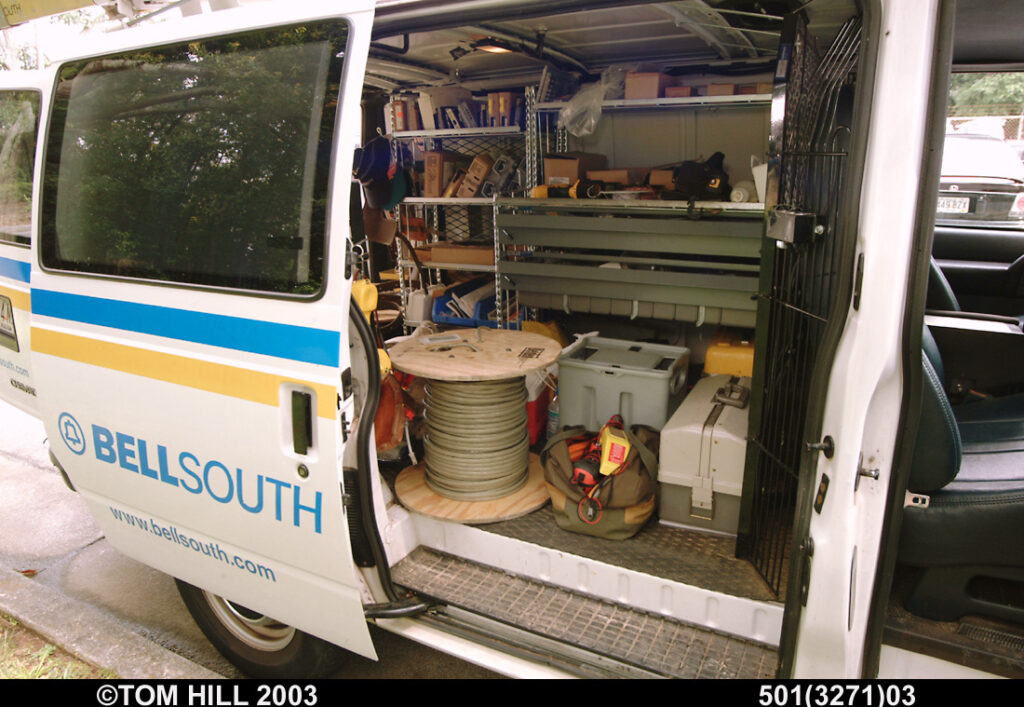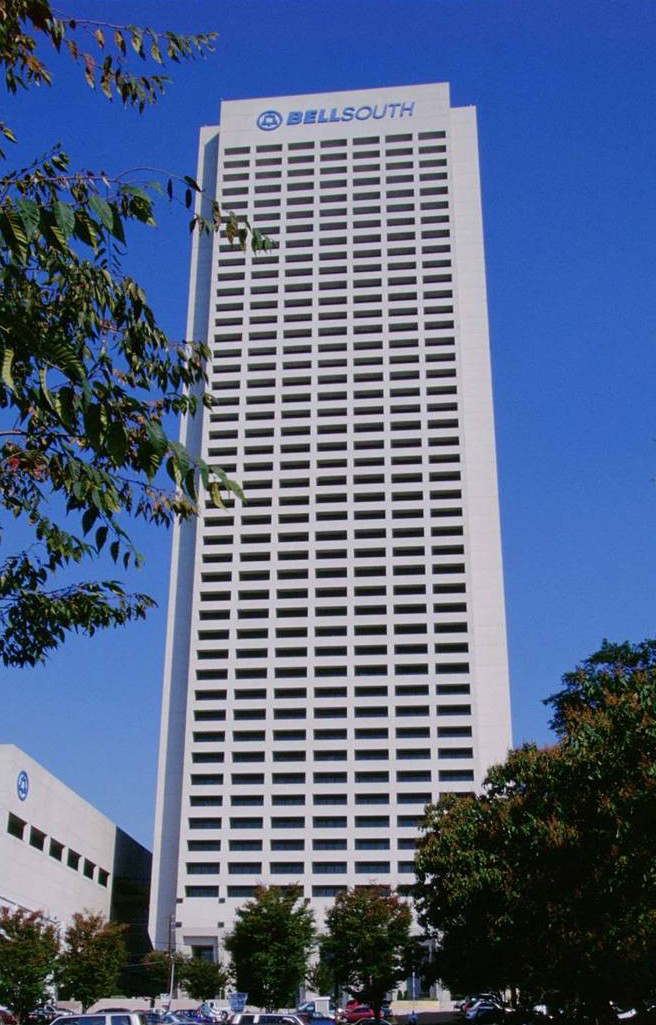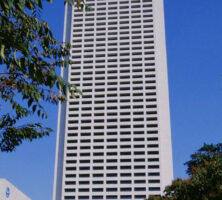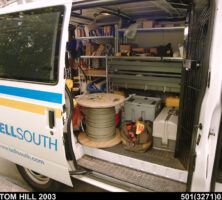Atlanta-based BellSouth Corporation was created, along with six other Regional Bell Operating Companies, on January 1, 1984, at the divestiture of American Telephone and Telegraph (AT&T). Until its remerger with AT&T in December 2006, BellSouth remained the only Regional Bell still using the universally recognized bell symbol and name as part of its corporate identity. The corporation’s headquarters were located in Atlanta at Peachtree and Fourteenth streets.
BellSouth’s territory included Alabama, Florida, Georgia, Kentucky, Louisiana, Mississippi, North Carolina, South Carolina, and Tennessee. Prior to the remerger with AT&T, BellSouth was a Fortune 100 communications company providing telephone, Internet, and television services to its customers, which included residential consumers, small and large businesses, and other entities in the health care, education, and government sectors.
Southern Bell
From 1879 to 1984 AT&T held a federally regulated, legally sanctioned monopoly—generally referred to as the Bell System—on all telephone services, products, and innovations in the United States. The monopoly format grew from the philosophy—adopted by many in the early days of the telephone’s invention in 1876—that the nation required a unified, standardized system to provide telephone and other public utilities with acceptable reliability. Never universal, the acceptance of this philosophy dissolved with the advent of new technologies and competitive economic forces in the 1960s and 1970s.
During the Bell System years Georgia was served by the operating company Southern Bell Telephone and Telegraph Company. In the late 1920s prominent architect P. Thornton Marye designed the Southern Bell Telephone Building, which still stands in downtown Atlanta. In 1980 a new building was completed on West Peachtree Street, in Midtown Atlanta, by the local firm FABRAP, in conjunction with Skidmore Owings and Merrill of New York.
AT&T, often referred to as “Ma Bell,” became mired in public debate and legal challenges. The 1984 divestiture of the Bell System was core to an agreement between AT&T and the U.S. Justice Department to resolve an antitrust case. The nation’s then twenty-two local Bell operating companies were reconfigured into seven separate holding companies, each responsible for providing local telephone service to a different region. As part of this reconfiguration, Southern Bell merged with South Central Bell Telegraph Company to form the BellSouth Corporation.
BellSouth Corporation
Under the leadership of John Clendenin, chief executive officer from 1984 to 1996, BellSouth Corporation began its transformation into a stand-alone company. Clendenin was succeeded in 1997 by Duane Ackerman, who led the company as chairman and chief executive officer until the merger with AT&T in 2006.

Courtesy of AT&T
During these years BellSouth retained its federally regulated southeastern monopoly on providing local telephone and other services and received limited rights to enter specified businesses. BellSouth Enterprises was founded as an umbrella for the company’s unregulated businesses, the largest of which was BellSouth Mobility, its wireless operation. Other areas under BellSouth Enterprises included international business; advertising and publishing, which handled Yellow Pages sales and composition; printing; equipment manufacturing; and information systems. A separate group, Science and Technology, was charged with developing new products and processes and provided BellSouth with a steady income stream via the licensing of patents.
BellSouth Mobility, created for the domestic market, was launched in 1984. Although U.S. customers were initially reluctant to use mobile phones, demand grew steadily. By the late 1990s BellSouth was adjusting to the reality that many people no longer required landline telephone service in their homes. In 2001 BellSouth Mobility morphed into Cingular Wireless under the direction of president and chief executive officer Stephen Carter, who was succeeded in late 2002 by Stan Sigman.
In 1985 BellSouth was the first of its Regional Bell peers to deploy the then-new technology of fiber-optic cable. The company laid 57,000 miles of fiber instead of traditional copper, thereby creating the foundation for evolving broadband (or high-speed) capabilities. By 2005, 5.3 million miles of fiber, more than any other company nationwide, had been placed throughout BellSouth’s region.
The passage of the Telecommunications Act of 1996 marked a new era in the communications marketplace. BellSouth underwent a transition from being the consumer’s only choice for local service to being one of many telecommunications competitors—including its former parent, AT&T—vying for local customers.
International partnerships, built on BellSouth’s experience with U.S. systems, were an important piece in the company’s overall growth strategy. By 1999 BellSouth provided service to more wireless devices overseas than it did in the United States. Over time, however, these international partnerships dwindled, and in 2004, with Latin American currencies and economies fluctuating, BellSouth closed its last international offices to concentrate on the domestic market.
Legislative and regulatory hurdles prevented BellSouth from providing long-distance service until 2002. Despite low profits, the company pursued the business because its existing physical infrastructure reduced implementation costs and because the general population had come to expect the option of receiving both local and long-distance service from a single provider.
Community Presence
The BellSouth Foundation, created in 1986, supported educational improvement and reform in the Southeast, with programs focused on helping students enhance their technology skills. From its inception through 2005, the foundation awarded 660 grants totaling more than $60 million and shared thousands of employee volunteer hours. In 2007 the foundation merged with the AT&T Foundation.

Courtesy of AT&T
The company also instituted the BellSouth Career Academy (later AT&T Career Academy) at Georgia Virtual Technical College (later Georgia Virtual Technical Connection). The academy provided online courses in electricity, electronics, and digital communications for prospective technicians.
In 1999 BellSouth announced plans to consolidate its employees, who were scattered in more than seventy locations around Atlanta, into three main centers accessible to MARTA. According to Ackerman, the project, which came to be known as the Atlanta Metro Plan, was designed both to reduce operating expenses and to help alleviate the “congestion and environmental challenges” posed by the city’s urban sprawl.
Among the Atlanta architectural firms involved with the design of the centers were Thompson, Ventulett, Stainback, and Associates (TVS), and Stanley, Love-Stanley. The centers were completed by 2003 and comprised the Lenox Park Center, which housed BellSouth’s customer operating units and Georgia operations; the Lindbergh Station Center, which housed BellSouth Entertainment and BellSouth.Net; and the Midtown Center, which housed BellSouth’s network and carrier services operations. In recognition of the company’s efforts, the Atlanta Regional Commission and Regional Business Coalition honored BellSouth with an Excellence Award in 2002.
In addition to the centers, at the time of the merger in 2006 BellSouth owned the Campanile Building (built in 1987 by TVS), which housed BellSouth’s corporate headquarters; the BellSouth Telecommunications Building on West Peachtree Street, which served as the company’s Atlanta headquarters; and Thornton’s old Southern Bell Telephone Building. As of 2009 AT&T maintained ownership of all this real estate, with the exception of the Campanile Building, which was sold after the merger.
Remerger with AT&T
By 2006, the year of its remerger with AT&T, BellSouth employed 63,000 people, and generated $33 billion in revenue. More than 40 percent of BellSouth’s revenue derived from its 40 percent ownership of Atlanta-based Cingular Wireless, which had 54.1 million subscribers. (The other 60 percent of Cingular was owned by AT&T prior to the merger.)
In December 2006, following months of negotiations, BellSouth was reabsorbed into AT&T. AT&T also acquired full ownership of Cingular Wireless in the deal. The transaction, estimated at $106 billion and including approximately $20.5 billion in BellSouth debt, was the largest deal worldwide in 2006 and the largest in Georgia’s history. Approved by the U.S. Department of Justice and the Federal Communications Commission, the merger was controversial and criticized by some smaller business entities, including Atlanta-based EarthLink.
Continuing the tradition of BellSouth’s philanthropy in Atlanta, AT&T increased BellSouth’s gift to the Woodruff Arts Center in 2006, and in 2007 the corporation donated $1 million to the Atlanta History Center, $1 million to the Piedmont Park Conservancy, and $350,000 to the Atlanta Women’s Foundation.
Although AT&T’s headquarters are located in San Antonio, Texas, offices for Cingular and for AT&T’s southeastern operations remain in Atlanta.







